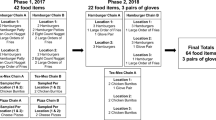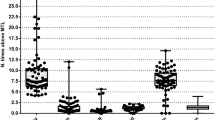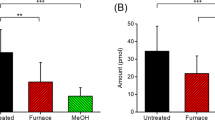Abstract
Background
ortho-phthalates and other plasticizers impart flexibility to plastics in food production, processing, and packaging; food consumption is a dominant plasticizer exposure pathway. Lower molecular weight ortho-phthalates are being replaced in plastic products due to toxicity concerns, but toxic hazards of and exposures to replacement ortho-phthalates and other plasticizers are poorly understood.
Objective
We measured 12 ortho-phthalates and 9 other plasticizers in conventional and organic U.S. food products to assess magnitude and profiles of contamination.
Methods
We measured plasticizers in 34 vegetable oils, 10 milks, 18 infant formulas, and 9 cheese powders from macaroni kits using gas chromatography coupled with mass spectrometry (GC-MS). We analyzed plastic packaging composition using FTIR spectroscopy.
Results
We detected eight ortho-phthalates and three alternatives ((1,2-cyclohexane dicarboxylic acid diisononyl ester (DINCH), diethylhexyl terephthalate (DEHT), and diisobutyl adipate (DIBA). Diethylhexyl phthalate (DEHP) was measured in all 71 products. DEHT had the highest concentration of any plasticizer (>10,000 ng/g in three oils). Oils had the highest total plasticizer (median = 770 ng/g, max = 14,900 ng/g) and milk the lowest (median = 88 ng/g, max = 120 ng/g). Organic milk and refined oils had higher median plasticizer levels than conventional. Refined oils had significantly lower concentrations than unrefined oils. Maximum contributors for every category were non-ortho-phthalates: DEHT (powdered infant formula and oils) and DIBA (cheese powder, milk and liquid formula). Plasticizers were not detected in packaging except epoxidized soybean oil in liquid formula lids.
Impact Statement
Human exposure to plasticizers is a significant public health concern. Nevertheless, sources of such exposures are poorly characterized. This study adds valuable information for estimating legacy and alternative plasticizer exposures from foods. The method developed for measuring DINCH, DINP and DIDP broadens the range of plasticizers other researchers may analyze in future work. The profiles of plasticizer contamination varied depending on the food type. We also document that food processing may be a source of plasticizer contamination in foods.
This is a preview of subscription content, access via your institution
Access options
Subscribe to this journal
Receive 6 print issues and online access
$259.00 per year
only $43.17 per issue
Buy this article
- Purchase on Springer Link
- Instant access to full article PDF
Prices may be subject to local taxes which are calculated during checkout


Similar content being viewed by others
References
US Consumer Product Safety Commission [CPSC], Toxicology Excellence for Risk Assessment Center at the University of Cincinnati [TERA]. Exposure Assessment: Potential for the Presence of Phthalates in Specified Materials at Concentrations Above 0.1 Percent. 2016.
Radke EG, Braun JM, Meeker JD, Cooper GS. Phthalate exposure and male reproductive outcomes: A systematic review of the human epidemiological evidence. Environ Int. 2018;121:764–93.
Swan SH, Main KM, Liu F, Stewart SL, Kruse RL, Calafat AM, et al. Decrease in Anogenital Distance among Male Infants with Prenatal Phthalate Exposure. Environ Health Perspect. 2005;113:1056–61.
Engel SM, Patisaul HB, Brody C, Hauser R, Zota AR, Bennet DH, et al. Neurotoxicity of ortho-phthalates: recommendations for critical policy reforms to protect brain development in children. Am J Public Health. 2021;111:687–95.
Zota AR, Calafat AM, Woodruff TJ. Temporal trends in phthalate exposures: findings from the National Health and Nutrition Examination Survey, 2001-2010. Environ Health Perspect. 2014;122:235–41.
Edwards L, McCray NL, VanNoy BN, Yau A, Geller RJ, Adamkiewicz G, et al. Phthalate and novel plasticizer concentrations in food items from U.S. fast food chains: a preliminary analysis. J Expo Sci Environ Epidemiol. 2021;32:366–73.
Gkrillas A, Dirven H, Papadopoulou E, Andreassen M, Hjertholm H, Husøy T. Exposure estimates of phthalates and DINCH from foods and personal care products in comparison with biomonitoring data in 24-hour urine from the Norwegian EuroMix biomonitoring study. Environ Int. 2021;155:106598.
Qadeer A, Kirsten KL, Ajmal Z, Jiang X, Zhao X. Alternative plasticizers as emerging global environmental and health threat: another regrettable substitution? Environ Sci Technol. 2022;56:1482–8.
Cao XL. Phthalate esters in foods: sources, occurrence, and analytical methods. Compr Rev Food Sci Food Saf. 2010;9:21–43.
Fromme H, Gruber L, Schuster R, Schlummer M, Kiranoglu M, Bolte G, et al. Phthalate and di-(2-ethylhexyl) adipate (DEHA) intake by German infants based on the results of a duplicate diet study and biomonitoring data (INES 2). Food Chem Toxicol Int J Publ Br Ind Biol Res Assoc. 2013;53:272–80.
Serrano SE, Braun J, Trasande L, Dills R, Sathyanarayana S Phthalates and diet: a review of the food monitoring and epidemiology data [Internet]. 2014. http://www.ehjournal.net/content/13/1/43.
Guo Y, Kannan K. Challenges encountered in the analysis of phthalate esters in foodstuffs and other biological matrices. Anal Bioanal Chem. 2012;404:2539–54.
Fierens T, Van Holderbeke M, Willems H, De Henauw S, Sioen I. Transfer of eight phthalates through the milk chain - A case study. Environ Int. 2013;51:1–7.
Lestido-Cardama A, Sendón R, Bustos J, Lomo ML, Losada PP, de Quirós ARB. Dietary exposure estimation to chemicals transferred from milk and dairy products packaging materials in spanish child and adolescent population. Foods 2020;9:1554.
Wu P, Yang D, Zhang L, Shen X, Pan X, Wang L, et al. Simultaneous determination of 17 phthalate esters in edible vegetable oils by GC-MS with silica/PSA-mixed solid-phase extraction: Gas Chromatography. J Sep Sci. 2012;35:2932–9.
Luo Q, Liu ZH, Yin H, Dang Z, Wu PX, Zhu NW, et al. Global review of phthalates in edible oil: An emerging and nonnegligible exposure source to human. Sci Total Environ. 2020;704:135369.
Domínguez-Romero E, Komprdová K, Kalina J, Bessems J, Karakitsios S, Sarigiannis DA, et al. Time-trends in human urinary concentrations of phthalates and substitutes DEHT and DINCH in Asian and North American countries (2009–2019). J Expo Sci Environ Epidemiol. 2023;33:244–54.
Schecter A, Lorber M, Guo Y, Wu Q, Yun SH, Kannan K, et al. Phthalate concentrations and dietary exposure from food purchased in New York State. Environ Health Perspect. 2013;121:473–94.
Guo Y, Zhang Z, Liu L, Li Y, Ren N, Kannan K. Occurrence and profiles of phthalates in foodstuffs from China and their implications for human exposure. J Agric Food Chem. 2012;60:6913–9.
Miller G, Gearhart J. A rapid screening method for detecting hazardous chemicals in consumer products, food contact materials, and thermal paper receipts using ATR-FTIR spectroscopy. J Environ Health. 2022;85:8–15.
Hanušová K, Vrbík K, Rajchl A, Dobiáš J, Sosnovcová J. Migration of epoxidised soybean oil from PVC gaskets of commercial lids: simulation of migration under various conditions and screening of food products from Czech markets. Food Addit Contam Part Chem Anal Control Expo Risk Assess. 2015;32:427–37.
Gharby S. Refining vegetable oils: chemical and physical refining. Sci World J. 2022;2022:6627013.
CDC. Facts: Breastfeeding [Internet]. Available from: https://www.cdc.gov/breastfeeding/data/facts.html.
Rossen LM, Simon AE, Herrick KA. Types of infant formulas consumed in the United States. Clin Pediatr (Philos). 2016;55:278–85.
Every Child is Unique, Special, Different [Internet]. gotmilk.com. [cited 2022 Dec 12]. Available from https://www.gotmilk.com/every-child-is-unique-special-different/.
Sifferlin A. The 10 Best and Worst Oils For Your Health. Time Magazine [Internet]. 2018 Jul 23; Available from: https://time.com/5342337/best-worst-cooking-oils-for-your-health/.
Bui TT, Giovanoulis G, Cousins AP, Magnér J, Cousins IT, de Wit CA. Human exposure, hazard and risk of alternative plasticizers to phthalate esters. Sci Total Environ. 2016;541:451–67.
Weng X, Zhu Q, Liao C, Jiang G Cumulative Exposure to Phthalates and Their Alternatives and Associated Female Reproductive Health: Body Burdens, Adverse Outcomes, and Underlying Mechanisms. Environ Sci Technol. 2023.
CDC. 2019: Fourth National Report on Human Exposure to Environmental Chemicals: Updated Tables, January 2019, Volume One [Internet]. U.S. Department of Health and Human Services, Centers for Disease Control and Prevention (CDC); 2019. p. 866. Report No.: CS272983-A. Available from: https://www.cdc.gov/exposurereport/pdf/FourthReport_UpdatedTables_Volume1_Jan2019-508.pdf.
Ezerskis Z, Morkūnas V, Suman M, Simoneau C. Analytical screening of polyadipates and other plasticisers in poly(vinyl chloride) gasket seals and in fatty food by gas chromatography-mass spectrometry. Anal Chim Acta. 2007;604:29–38.
Shi L, Zheng L, Liu R, Chang M, Huang J, Jin Q, et al. Quantification of polycyclic aromatic hydrocarbons and phthalic acid esters in deodorizer distillates obtained from soybean, rapeseed, corn and rice bran oils. Food Chem. 2019;275:206–13.
Chen L, Liu YL, Deng JL. Removal of phthalic acid esters from sea buckthorn (Hippophae rhamnoides L.) pulp oil by steam distillation and molecular distillation. Food Chem. 2019;294:572–7.
Carlos KS, de Jager LS, Begley TH. Investigation of the primary plasticisers present in polyvinyl chloride (PVC) products currently authorised as food contact materials. Food Addit Contam Part A 2018;35:1214–22.
Rubio L, Valverde-Som L, Sarabia LA, Ortiz MC. The behaviour of Tenax as food simulant in the migration of polymer additives from food contact materials by means of gas chromatography/mass spectrometry and PARAFAC. J Chromatogr A 2019;1589:18–29.
Page BD, Lacroix GM. The occurrence of phthalate ester and di-2-ethylhexyl adipate plasticizers in Canadian packaging and food sampled in 1985-1989: a survey. Food Addit Contam. 1995;12:129–51.
Fierens T, Van Holderbeke M, Willems H, De Henauw S, Sioen I. Phthalates in Belgian cow’s milk and the role of feed and other contamination pathways at farm level. Food Chem Toxicol. 2012;50:2945–53.
Sharman M, Read WA, Castle L, Gilbert J. Levels of di‐(2‐ethylhexyl)phthalate and total phthalate esters in milk, cream, butter and cheese. Food Addit Contam. 1994;11:375–85.
Koca N, Erbay Z, Kaymak-Ertekin F. Effects of spray-drying conditions on the chemical, physical, and sensory properties of cheese powder. J Dairy Sci. 2015;98:2934–43.
Corkery M Annie’s Pledges to Purge a Class of Chemicals From Its Mac and Cheese. The New York Times [Internet]. 2021 Apr 19 [cited 2022 Dec 19]; Available from: https://www.nytimes.com/2021/02/19/business/annies-mac-cheese-plastic-phthalates.html.
Voorspoels Stefan NH Jo Lievens, Guido Vanermen. Final Report: Analysis of Selected Phthalates in Food Samples. VITO; Ecology Center; 2017.
Sebastian, Rhonda S., Goldman, Joseph D., Enns, Cecilia W., LaComb, Randy P. What We Eat In America, NHANES 2005-2006: Fluid Milk Consumption in the United States. USDA Food Surveys Research Group, Dietary Data Brief3; 2010.
Acknowledgements
We thank Ecology Center research assistants Jocelyn Marchyok, Daniela Tapia, and Dominique Valentine for carrying out market research, sample management, and FTIR spectroscopy for this study. We thank our nonprofit partners Center for Food Safety, Healthy Babies Bright Futures, Learning Disabilities Association, Toxic Free Future, and WE ACT for Environmental Justice for collaborating on the study conception and sample selection.
Funding
This study was funded by the Passport Foundation, Forsythia Foundation, and Marisla Foundation.
Author information
Authors and Affiliations
Contributions
RK carried out statistical analyses, literature research, and outlined and helped write the manuscript. GZM carried out FTIR data analyses, product label analyses, literature research, and helped write the manuscript. MB helped conceive of the study design and sample selection and provided feedback on the manuscript. JG helped conceive of the study design and sample selection and provided feedback on the manuscript. VK carried out sample preparation, GC/MS analysis, and data collection. SL carried out sample preparation, GC/MS analysis, and data collection. KK helped design the study, supervised the GC/MS analysis, advised on the data interpretation, and provided feedback on the manuscript.
Corresponding author
Ethics declarations
Competing interests
The authors declare no competing interests.
Ethical approval
Ethical approval was not required as there were no human subjects involved in this study.
Additional information
Publisher’s note Springer Nature remains neutral with regard to jurisdictional claims in published maps and institutional affiliations.
Supplementary information
Rights and permissions
Springer Nature or its licensor (e.g. a society or other partner) holds exclusive rights to this article under a publishing agreement with the author(s) or other rightsholder(s); author self-archiving of the accepted manuscript version of this article is solely governed by the terms of such publishing agreement and applicable law.
About this article
Cite this article
Krithivasan, R., Miller, G.Z., Belliveau, M. et al. Analysis of ortho-phthalates and other plasticizers in select organic and conventional foods in the United States. J Expo Sci Environ Epidemiol 33, 778–786 (2023). https://doi.org/10.1038/s41370-023-00596-0
Received:
Revised:
Accepted:
Published:
Issue Date:
DOI: https://doi.org/10.1038/s41370-023-00596-0



